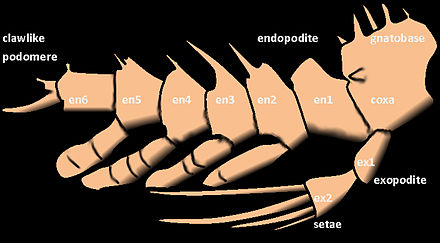Agnostus
Agnostus[1] is a genus of agnostid trilobites, belonging to the family Agnostidae, that lived during the late Middle Cambrian – early Upper Cambrian (about 506 to 492 million years ago). It is the type genus of the family Agnostidae and is subdivided into two subgenera, Agnostus and Homagnostus.[2][3]
Agnostus is from the Ancient Greek άγνωστος (ágnostos) "unknown", and reflects the fact that early paleontologists did not know what type of animal with which they were confronted. The species epithet has this origin:
Like all Agnostida, Agnostus is diminutive and the headshield (or cephalon) and tailshield (or pygidium) are around the same size (or isopygous) and outline. As in all Agnostina, Agnostus has two thorax segments. When Agnostina are enrolled, a tiny opening between the cephalon and the thorax becomes visible (the cephalothoracic aperture) that uniquely distinguishes this group from the Eodiscina. Two features shared with all Agnostoidea are that the basal glabellar lobes are anteriorly expanded, and that the frontal lobe of the central raised area of the cephalon (or glabella) is not laterally expanded compared to the backward lobe. This is unlike in the Condylopygoidea. In all Agnostidae the cephalic border is narrow and the pygidial axis is simple, the posterior lobe not wider than the anterior (or axiolobate), and usually long but not reaching border furrow. In Agnostus the glabella is connected to the border by a median preglabellar furrow. The anterior glabellar lobe is ogival or rounded at its front. The posterior lobe tapers forward. The glabella carries an axial node level with or slightly behind a variably developed second furrow. The pygidium has a long axis, although this usually does not reach the border furrow. The pygidial axis (or rhachis) is not connected to the border by a median (postaxial ) furrow. The pygidium carries backward directed spines on its margins, where it curves back towards the midline.
In the subgenus Agnostus (Agnostus), the axis of the pygidium is relatively narrow, ending pointed, or narrowly rounded, and furrows crossing the pygidial axis are weak at best. The subgenus Agnostus (Homagnostus) has a broadly rounded termination of the axis extending nearly to posterior border furrow. The axis is narrower halfway along its length and crossing furrows are well developed.[5]
Agnostid appendages are known only from exceptionally preserved specimens of Agnostus pisiformis from the Upper Cambrian Orsten deposits of Sweden (Müller & Walossek 1987) [6] and the appendages of meraspid developmental stages of A. pisiformis (½-1 mm total body length) are the best preserved of any trilobite found so far.[5] The species has nine pairs of appendages, the antennules and eight pairs of "legs" that differ in size and composition. Four pairs of appendages originate from the cephalon, two from the thorax, and three from the pygidium. The frontal antennule are short and stout. The most forward pair of "legs" has a small coxa, a seven-podomere exopodite carrying long, bristle-like setae and gill-like extensions, and no endopodite. The second pair has a five-podomere exopodite and a six-podomere endopodite. The third has a three-podomere exopodite and a six-podomere endopodite. The fourth has a two-podomere exopodite and a seven-podomere endopodite. The fifth has a single-podomere exopodite and a six-podomere endopodite. Further appendages are more and more reduced in size and complexity (Müller & Walossek 1987).
Agnostus is said to have had a cosmopolitan distribution. The nominate subgenus occurs from the late Middle Cambrian to the early Upper Cambrian, while the subgenus Agnostus (Homagnostus) is restricted to the early Upper Cambrian.

